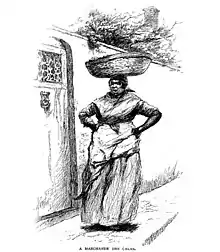A marchande was a female street or country merchant or vendor local to the Mississippi delta (and Louisiana in particular) known for selling Creole cuisine, fruits, vegetables, and other household items.[1][2]

Calas vendor, New Orleans, 1886
Marchandes were common in southern Louisiana until the end of the 20th century, after which the marchande as a phenomenon became obsolete.
The Federal Writers Project includes an account of a marchande "crossing the ferry at Westwego with a basket of blackberries on her head". In the account, the marchande's "easy, familiar fashion" is compared to the approach that 19th and 20th century Creole had to Christianity (with God as a "close friend").[3]
Many Creole slaves functioned as marchandes during the week, selling produce and performing household tasks on weekends when markets were closed.[4] It was also possible for freed slaves to establish themselves as la marchande in their local communities.[5] Many Creoles procured a large proportion of their goods this way; in open markets run by a combination of slaves and former slaves.[4]
See Also
References
- ↑ James R. Creecy (1860). Scenes in the South: And Other Miscellaneous Pieces. T. McGill, printer. pp. 39–.
- ↑ Ulentin, Anne. Shades of Grey: Slaveholding Free Women of Color in Antebellum New Orleans, 1800-1840 (Thesis). Louisiana State University.
- ↑ Federal Writers Project (2013), WPA Guide to Louisiana, Trinity University Press, ISBN 9781595342164
- 1 2 Creecy, James R. (1860), Scenes in the South (And Other Miscellaneous Pieces), University of Michigan
- ↑ Gentry, Judith F. (2009), Louisiana Women; Their Lives and Times, University of Georgia Press, p. 57, ISBN 9780820329468